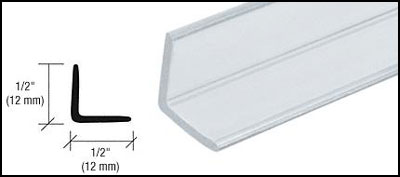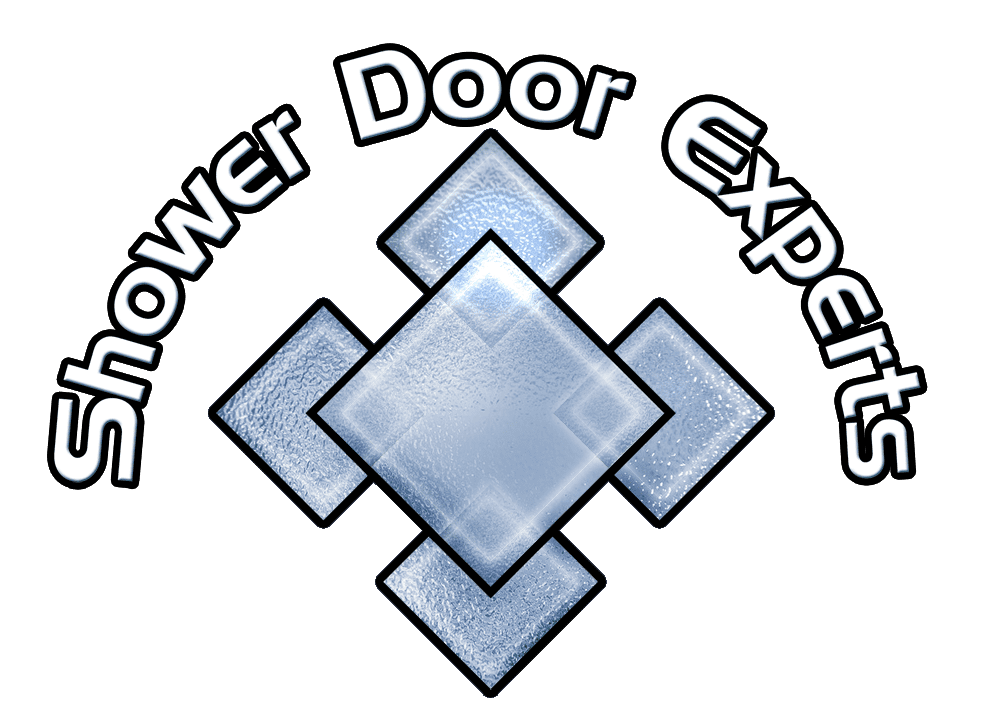Our Experts speak the language of shower doors fluently! But we’re realistic: we don’t expect our customers to be as familiar with the shower door industry jargon and technical terms. So we put together this glossary to help bridge the communication divide! Because there are bound to be words and phrases you’ve never heard before, and we want you to be as informed and knowledgeable as possible as you finalize your purchase.
You can always reach out to us directly though too if you have any questions about our products or shower door terminology! Our enthusiasm for the nuts and bolts of shower doors is borderline weird, in fact – our company could just as easily be called Shower Door Nerds!
A | B | C | D | E | F | G | H | I | J | K | L | M | N | O | P | Q | R | S | T | U | V | W | X | Y | Z
A
Acid Etched Glass – Permanently altered through the application of a hydrofluoric acid solution, this translucent glass has a smooth and even surface. Visually similar to sandblasted glass, but whereas sandblasting provides a relatively rough surface which tends to allow the retention of oil, dirt and dust particles, acid etching provides a much finer surface. This minimizes the amount of fingerprints picked up by the glass surface, which has great appeal because acid etched glass continues to look uniform long after sandblasted glass becomes stained, and its fine surface is easier to clean and maintain.
Anodized Aluminum – Anodizing is an environmentally safe electrochemical process that converts the aluminum metal surface into a porous aluminum oxide, ultimately creating an end product whose finish is more durable and element-resistant. Popular for shower extrusions due to its durability, color stability, ease of maintenance, and cost, it revolutionized the industry as an alternative to solid brass.
B
Bracket – See: “Clip”
Bulb Seal – A rarely used but handy vinyl piece designed for sealing gaps and preventing leaks, it can be adhered to a wall or stationary glass with VHB Tape.
Bulkhead – a built down ceiling, used in shower areas to lower the height of full-height steam showers
Bullnose Tile – End cap tile, typically with an eased edge, used to terminate field tile
Buttress – Any horizontal surface with stationary glass that rests higher than the curb of the shower (i.e., tub decks, knee walls, etc.)
Buttressed Corner Unit – A shower enclosure consisting of a door, a notched inline panel, and a return panel that sits on a tub deck or knee wall
Buttressed Panel – A stationary panel whose full base width sits on a buttress
Buttressed Return Panel – A buttressed panel that meets the front face of a shower at ninety degrees
Bypass – A shower system that uses two sliding pieces of glass in lieu of a hinged swing door, these units may or may not require additional stationary glass panels to enclose a shower space. A popular choice for bath tubs, bypasses are low-maintenance and cost-effective.
C
C-pull – Standard shower handle in the shape of the capital letter “C,” usually back-to-back through ½” holes in a door
C-pull Towel Bar Combo – handle system with a c-pull handle on one side of a shower door and a towel bar on the other side, also known just as a C-Pull Combo
Caulk – See: “Silicone“
Clamp – See: “Clip“
Clip – a metal clamp or bracket that attaches glass to walls or glass to glass. Made of solid brass and plated in a finish complementary to the hinges, handle, etc., clips can be used to accomplish a more frameless look by stabilizing stationary glass. Ultimately, the tile job determines whether or not clips can be used in lieu of u-channel, as significant, aggressive outages in the plumb and level conditions can make for sloppy silicone seams. See: “Glass-to-Wall Clip” and “Glass-to-Glass Clip“
Corner Clip – a clip used to stabilize two stationary pieces of glass meeting at 90 degrees, it’s frequently used on frameless corner units without a header.
Corner Unit – A shower enclosure consisting of a door, an inline stationary panel, and a return panel
D
Deflection – movement or wobble of stationary panels
Detail Tile – tile that projects above or outward from surrounding tile (i.e., listello bands, bench seat overhangs, etc.), it’s a design flourish that may or may not factor into how a shower door is engineered or installed. Oftentimes, we will notch detail tile, cutting out a recess or groove that allows the glass or u-channel it will accommodate to sit flush with surrounding tile. See also: “Notch”
Door Jamb – The metal or vinyl piece a shower door closes against
E
Extrusions – the metal fittings or hardware (i.e., u-channel, wall jambs, headers, etc.) used in the manufacturing and installation of shower enclosures
F
Finish – The plating over solid brass or anodized aluminum (i.e., chrome, brushed nickel, oil rubbed bronze, etc.)
Framed – Framed shower enclosures are the most cost effective because they typically use 3/16” tempered or laminated glass with fairly substantial anodized aluminum extrusions. Although these units aren’t as flashy as fully frameless enclosures, our framed systems are built to last and are generally more attractive than comparable products from big-box home improvement stores. We do not offer any builder’s grade framed systems, the kind usually pre-installed in McMansions. Our framed showers are custom built for each individual space.
Frameless – Frameless shower enclosures use either 3/8” or 1/2” tempered glass and either brass plated or anodized aluminum hardware. Within the shower industry, “frameless” refers to any shower enclosure that doesn’t have metal adhered to the edge of the glass. Some people think frameless means no metal whatsoever. This is not the case. Frameless units can be virtually metal-free, except for clips on any stationary panels, hinges, and handle. But frameless also covers units that may have a header atop the unit and u-channel on the stationary panels.
Front Face – In a shower with glass on more than one side, the front face is the side of the shower that contains the door.
G
Glass – A hard, brittle, noncrystalline, more or less transparent substance produced by fusion, usually consisting of mutually dissolved silica and silicates that also contain soda and lime.
Glass Sealant – A product that seals the pores of glass, acting as a Teflon coating of sorts, to prevent the buildup of soap scum, mineral deposits, etc. Diamond Fusion, Cardinal Armor, and Cardinal 10 are a few of the glass sealant products we carry.
Glass-to-Glass Clip – A clip that that stabilizes stationary panels adjacent to one another
Glass-to-Glass Pivot Hinges – A solid brass pivot hinge system that allows for hinging a door off of a stationary panel, negating the need for a header. They distribute the weight of the door downward towards the curb instead of having the stationary panel bear the full load of the door weight.
Glass-to-Glass Swing Hinges – Also known as “GG Hinges,” these hinges are less preferable than glass-to-glass pivot hinges, as they distribute the weight of the door entirely to the stationary panel it’s hinged off of. Still, they’re a good option when a hinge location must be against a stationary panel and a header isn’t an option.
Glass-to-Wall Clip – A clip that stabilizes a stationary panel by attaching it to the wall, negating the need for u-channel
Glass-to-Wall Pivot Hinges – A pivot hinge system with a leg on the top hinge that gets screwed into the wall, allowing a door to be hinged in a way that negates the need for a header. Pivot hinge systems distribute the weight of the door downward towards the curb, which can be preferable, depending on the placement and degree of backing behind the tile.
Glass-to-Wall Swing Hinges – Solid brass hinges, also known as “swing” or “patch” hinges, these are located approximately 8” from the top and 8” from the bottom of a frameless shower door. They require 2×4 backing to have enough meat to anchor the full weight of the door, as each hinge requires four screws.
H
Hard L – A vinyl with many applications, but used primarily against the strike side of a door to give the unit something firm to close against, acting as a jamb, and to seal the gap between the strike side of the door and the wall or stationary panel adjacent to it.

Hardware – Any metal shower components (i.e., hinges, headers, handles, clips, etc.)
Hardware Finish – See: “Finish”
Header – Metal support at the top of a shower, it’s used to support the door and any additional panels. It bears the weight of the door, allowing for hinge location adjacent to a stationary panel. It also stabilizes and reduces deflection on stationary panels. Standard headers range from 1 ¼” to 3” thick.
Hinges – Solid brass or aluminum mechanisms that support the weight of a door and allow it to swing inward and/or outward. See: “Glass-to-Glass Pivot Hinges,” “Glass-to-Glass Swing Hinges,” “Glass-to-Wall Pivot Hinges,” and “Glass-to-Wall Swing Hinges”
Hinge Side – The side of the door with hinges, opposite of the “Strike Side”
Hook – See: “Robe Hook”
Hydroslide – A modern shower system with only one sliding panel
I
Inline Panel – A panel directly beside and on the same horizontal plane as a door
Inset Transom – A swivel vent for steam showers completely contained within a door or stationary panel, it’s essentially cut out of the piece that contains it and mounted with clips that allow it to be adjusted as necessary. See: “Transom”
J
K
Knee Wall – A raised surface (terminating higher than the shower curb) that requires a notched panel and/or a buttress panel
Knob – A small, minimalist handle usually measuring approximately ¾” x 1 ¾”.
L
Laminated Glass – Laminated Glass consists of two layers of glass compressed against a piece of transparent plastic. A laminated Glass has this plastic sheeting between the layers so that the glass is prevented from shattering.
Listello Tile – See: “Detail Tile”
Lip – See: “Overhang”
Lite – A stationary piece of glass
Low Iron Glass – Also known as Starfire glass, low iron glass is crystal clear, lacking the slight green tint that clear tempered glass can show ever so slightly on the edge. It’s iron that causes this slight hue, so low iron glass is required in situations where clear tempered glass will not suffice.
M
Mitered Edge – Whereas glass is usually cut with 90 degree edges, it can alternative be cut with 45 degree angles so that a mitered door strikes against a mitered panel to overlap and interlock. This can be great for eliminating vinyls in that gap, but it can be problematic if the door is pulled past the panel’s edge.
N
Neo Angle – A shower design usually consisting of three pieces of glass where two stationary panels meet a door at 135 degrees. See also: “Two-thirds Neo Angle”

Notch – A recess or groove cut into raised detail tile or an overhang to allow glass or u-channel to sit flush with surrounding tile
Notched Corner Unit – See: “Buttressed Corner Unit”
Notched Panel – A stationary glass panel with a cutout, usually to accommodate a tub deck or knee wall, they look like the state of Oklahoma flipped on its panhandle.
O
Operable Transom – a swivel vent, it is used in steam showers to regulate the volume of steam. The operable transom clips can attach to walls, stationary glass, or headers. Alternatively, they can be completely inset in a door or stationary panel. See: “Inset Transom”
Outage – Any surface condition with greater than or equal to 1/16” out of plumb (vertical surfaces) or out of level (horizontal surfaces)
Overhang – A lip of tile or granite that extends slightly past a knee wall or bench seat, usually requiring notching to accommodate stationary glass
P
Pivot hinges – See “Glass-to-Glass Pivot Hinges,” “Glass-to-Wall Pivot Hinges”
Polycarbonate – See: “Vinyl”
Q
R
Return – A horizontal surface located ninety degrees from the curb of the shower
Return Panel – Stationary glass that meets the front face of the shower at ninety degrees
Robe Hook – A through-the-glass option for doors or panels that costs less and takes up less space than a towel bar while performing a similar function
S
Sandblasting – Surface treatment in which sand is blown against glass at a high velocity to produce a roughened, opaque surface. We use glass sealant on both sides of our sandblasted glass to guard against the accumulation of dirt and oils, as the sandblasting process makes glass, which is already relatively porous, more susceptible to discoloring and deterioration.
Seal – Any vinyl piece meant to prevent a shower enclosure from leaking
Semi-frameless – Semi-frameless shower enclosures typically use 1/4” tempered glass and anodized aluminum hardware. A custom shower deemed “semi-frameless” has a header atop the unit, and any stationary glass is fully framed with slim profile channel. The door itself, however, does not have framing around it, hence the term “semi-frameless.”
Shower Screen – See: “Spray Panel”
Silicone – a translucent caulk product used to seal the edges and seams of shower enclosures, its main function is to prevent leaking. Our silicone has a mildew-resistant additive to keep it clean and relatively transparent over time.
Sill – a semi-round metal piece or polycarbonate block mounted to the curb, it’s positioned directly underneath the door in its closed position to act as a dam and prevent leaking.
Slider – See: “Bypass”
Spray Panel – A hinged or stationary piece of glass that takes up only part of a shower or tub opening, oftentimes they have a curved radius edge on the top outer corner.
Starfire Glass – See: “Low Iron Glass“
Stationary Panel – Any unhinged piece of glass adhered to a surface with clips or u-channel and unable to move
Stationary Transom – associated with steam shower units, it’s a stationary piece of glass above a door or header that brings the unit to the ceiling for a fully enclosed shower. Usually required for steam units with an overall height too tall (84”+) for a full-height door, it’s an economical alternative to an operable transom.
Strike Side – the side of the door with the handle, opposite of the “Hinge Side”
Sweep – vinyl piece attached to the bottom of a shower door with fins that drag against the curb to prevent leaking. Ideally, when the door is in its closed position the flexible fins of the sweep are set in a position straddling a sill.
T
Tempered Glass – Heat strengthened for safety, tempered glass is approximately four times as strong as standard glass. In the event of breakage tempered glass fractures into small particles which do not form sharp edges. This greatly reduces the chance of personal injury.
TPC Surface Protector – An after-market sealant that can be applied to glass, tile, and porcelain surfaces to act as a buffer from the elements. It reduces the time and energy spent cleaning your bathroom, while protecting the materials from wear and tear.
Transom – See: “Operable Transom,” “Stationary Transom,” “Inset Transom”
Tub Deck – The surrounding edges of a soaking tub, frequently adjacent to a corner unit and requiring a buttressed return panel
Two-thirds Neo Angle – A neo angle with only one stationary panel instead of the usual two
U
U-channel – typically used where glass meets tile, marble, or granite, it allows for adjustability of stationary panels and neat glass-to-metal and glass-to-wall silicone joints. Its primary function is to stabilize stationary glass panels.
V
VHB Tape – Very High Bond, double-sided adhesive frequently used to attach vinyls to various surfaces (i.e., glass, tile, etc.). In a pinch it can also be used to attach u-channel to surfaces, like certain tubs, that can’t be drilled into.
Vinyl – Any number of ancillary seals and wipes (Hard L, sweep, etc.) used to prevent leaking and solidify a frameless appearance
Vinyl L – See: “Hard L” or “Soft L”
Vinyl Sweep – See: “Sweep”
W
Wall Jamb – The framing on the wall of bypass sliding units that the sliding panels strike against
Wet Glaze – a seam where glass meets a wall or glass meets glass that uses only silicone in lieu of metal channel or clips
Wipe – See: “Sweep”
X
Y
Z
Our Hours
WE ARE OPEN
Open Monday – Friday, 8:30 AM to 4:30 PM
Weekends by appointment only
What Our Clients Say
An excellent experience with Shower Door Experts. Measurements were perfect. Custom shower glass panel is beautiful. And, the installers were great: professional, efficient, and very focused on doing everything right. Would definitely recommend.
Paula Law



